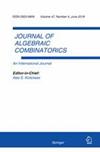Constructions and equivalence of Sidon spaces
IF 0.9
3区 数学
Q3 MATHEMATICS
引用次数: 0
Abstract
Abstract Sidon spaces have been introduced by Bachoc et al. (in: Mathematical Proceedings of the Cambridge Philosophical Society, Cambridge University Press, 2017) as the q -analogue of Sidon sets. The interest on Sidon spaces has increased quickly, especially after the work of Roth et al. (IEEE Trans Inform Theory 64(6):4412–4422, 2017), in which they highlighted the correspondence between Sidon spaces and cyclic subspace codes. Up to now, the known constructions of Sidon Spaces may be divided in three families: the ones contained in the sum of two multiplicative cosets of a fixed subfield of $$\mathbb {F}_{q^n}$$西顿空间的构造与等价
Bachoc等人(见:《剑桥哲学学会数学论文集》,剑桥大学出版社,2017年)将西顿空间作为西顿集的q -类似物引入。对西顿空间的兴趣迅速增加,特别是在Roth等人(IEEE Trans Inform Theory 64(6): 4412-4422, 2017)的工作之后,他们强调了西顿空间与循环子空间码之间的对应关系。到目前为止,已知的西顿空间的构造可分为三族:包含在$$\mathbb {F}_{q^n}$$ F q n的固定子域的两个乘积余集和中的构形,包含在$$\mathbb {F}_{q^n}$$ F q n的固定子域的两个以上乘积余集和中的构形,最后是作为子空间多项式核的构形。在本文中,我们将主要关注第一类例子,我们提供了表征结果,我们将展示一些新的例子,这些例子也来自一些众所周知的组合对象。此外,我们将给出一个相当自然的西顿空间间等价的定义,它依赖于循环子空间码的等价概念,我们将讨论已知例子的等价性。
本文章由计算机程序翻译,如有差异,请以英文原文为准。
求助全文
约1分钟内获得全文
求助全文
来源期刊
CiteScore
1.50
自引率
12.50%
发文量
94
审稿时长
6-12 weeks
期刊介绍:
The Journal of Algebraic Combinatorics provides a single forum for papers on algebraic combinatorics which, at present, are distributed throughout a number of journals. Within the last decade or so, algebraic combinatorics has evolved into a mature, established and identifiable area of mathematics. Research contributions in the field are increasingly seen to have substantial links with other areas of mathematics.
The journal publishes papers in which combinatorics and algebra interact in a significant and interesting fashion. This interaction might occur through the study of combinatorial structures using algebraic methods, or the application of combinatorial methods to algebraic problems.

 求助内容:
求助内容: 应助结果提醒方式:
应助结果提醒方式:


